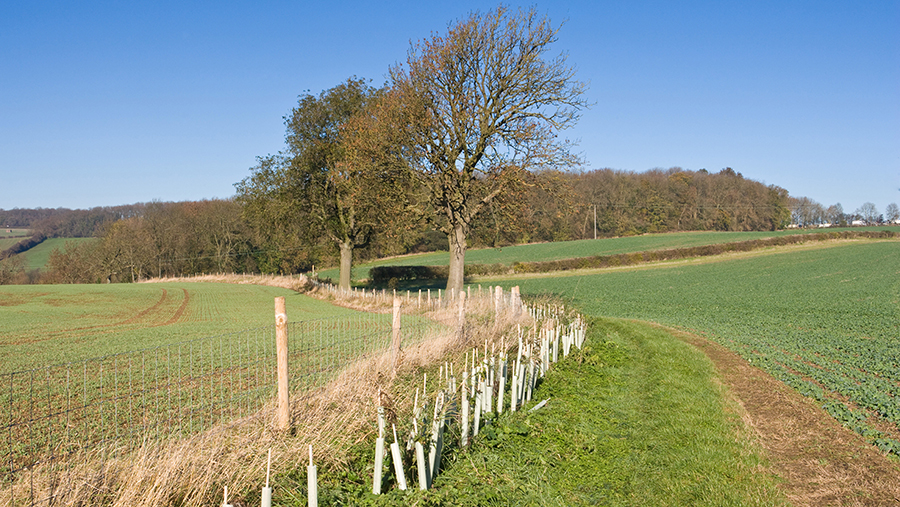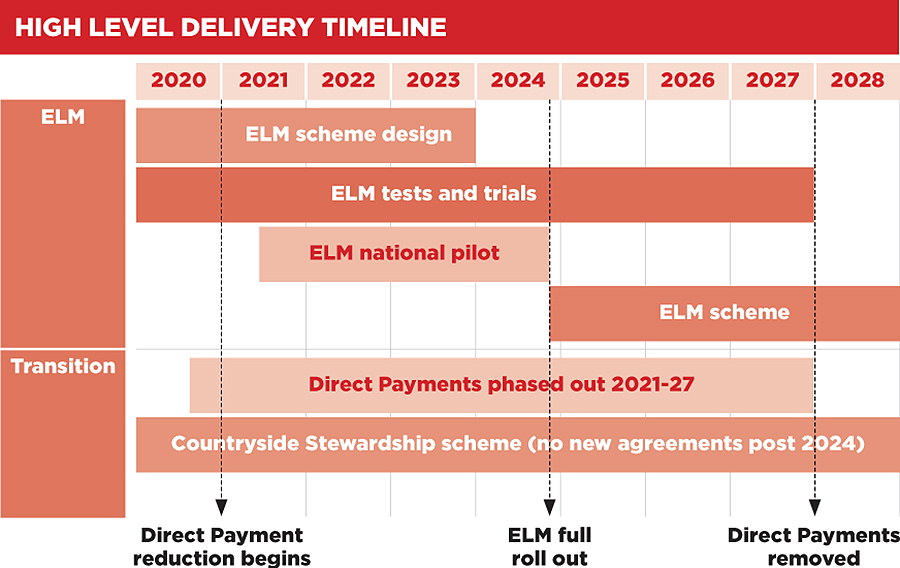Environmental Land Management scheme: The detail unpicked
 © Tim Scrivener
© Tim Scrivener A three-tier Environmental Land Management (ELM) scheme is being proposed by government as it seeks to move away from farm support based on direct payments to one centred on “public money for public goods”.
The planned new structure for English farmers is contained in a Defra discussion document setting out the government’s “initial thinking” on its green policy. Farmers and their representatives have been given 10 weeks to share their views.
See also: Defra confirms reductions in support for farmers
Setting out the new policy framework, Defra secretary George Eustice says British farming needs to become more sustainable “in the truest sense of the word”.
“We need an industry which is profitable, competitive and productive, while feeding the nation and taking care of our landscapes too,” he says.
“Now more than ever, efforts for the environment are absolutely critical, and no group has more power to reverse environmental decline than our farmers.”
Carbon targets
As well as helping to reverse biodiversity loss and improve air and water quality, the new ELM scheme is intended to help government meet its “net zero” carbon emissions target by 2050.
The Defra document also notes that, when it comes to delivering taxpayer support to farming (currently valued at about £2.5bn to English farmers) agri-environment schemes offer better value for money than the Basic Payment Scheme
But Defra notes that Countryside Stewardship has been less popular due to the high bureaucratic demands and, to succeed, ELMs will seek to achieve a high level of uptake.
As such, it is keen to hear from farmers and land managers about how they think the scheme can work.
“The responses we receive to this document will help to inform the detailed scheme design policy for both our national pilot, which is due to start in late 2021, and for the start of the ELM scheme in 2024,” it says
A more detailed consultation is anticipated at a later date.

Three-tier approach
Defra has looked to the recent past while spending the past two years developing its proposals for a new ELM scheme.
“Our early vision for ELMs was to offer one broadly accessible scheme, designed to work for all farmers, foresters and other land managers,” says the document.
“But as we began testing this design, we realised that previous schemes have been most successful when they have different ‘tiers’, as this provides the option of tailoring different elements to different needs.”
As such, the latest version of ELMs is based on three tiers:
Tier 1: Encouraging environmentally sustainable farming
Designed to be easy to engage with, farmers would be paid for measures that help address their direct environmental impacts.
These could include nutrient management, pest control, soil improvement, cover crops or planting wildflower margins to encourage sustainable farming.
The focus would be on practices that are most effective when delivered at scale. Defra is also thinking of grouping different actions into “packages”, for example an “upland package” for hill farmers.
Tier 2: Locally targeted environmental outcomes
This tier would focus on local needs, making sure the right things are delivered in the right places.
It would reward collaboration between land managers, and could include items such as tree and hedge planting, habitat restoration, natural flood management, rights of way provision, recreation infrastructure and education services.
Tier 3: Landscape scale, land-use change projects
These projects would aim to deliver “over and above” what can be achieved through Tiers 1 and 2, helping government meet its more ambitious environmental targets, such as nature recovery and net zero carbon emissions. It might include woodland creation, peatland restoration and the creation of coastal habitats.
“We want the three tiers to work together to offer participants a simple scheme,” says Defra. “We hope to ensure as much flexibility as possible, to participate across different tiers, and we are working to determine how they will fit together.”
As well as local involvement, Defra is looking to provide advisers – either private practitioners or government agents – to help farmers make the most of ELMs.
The public goods ELMs will pay for:
- Clean and plentiful water
- Clean air
- Protection from and mitigation of environmental hazards
- Mitigation of and adaptation to climate change
- Thriving plants and wildlife
- Beauty, heritage and engagement
What are the next stages?
Tests and trials have been ongoing since 2018, based in part on farmer suggestions and focusing on specific parts of ELMs. At present there are 46 such trials under way.
The next stage is to launch a national pilot, scheduled for late 2021, which will test various elements of the scheme in real world situations.
“It is clear that in the past IT systems, ill-conceived processes and unintended consequences of policy design have got in the way of delivery,” Defra admits. “The pilot is one of the primary mechanisms to ensure the ELM approach, its systems and processes work prior to the full rollout in 2024.”
Defra adds that it is key that farmers and other land managers enter into real agreements to deliver real outcomes as part of the pilot. “We could pay them to take part using some of the funding freed up by BPS reductions.”
How will farmers be paid?
Defra acknowledges that getting payments right will be critical to securing decent uptake of ELMs.
“We are considering a range of possible payment methodologies, exploring how to balance providing a fair payment to land managers against maximising value for money for taxpayers.”
Options include administrative price setting, with rates set by government), and market-based price setting, where payments are determined using mechanisms such as competitive tendering or auctions.
“We are also exploring innovative approaches, such as payment-by-results and how we could blend public with private finance within ELM,” Defra explains.
Payment by results would give farmers more scope to devise their own methodology and is more likely for Tier 2 schemes. For Tier 1, however, it emphasises the need for simplicity, basing payments on income forgone and costs incurred, to help keep the financial risks low.
It also recognises the need for more flexibility, both in terms of assessing farmers’ compliance and adjusting payments over time if rates need to be raised to achieve greater uptake.
Larger Tier 3 projects would likely be individually funded.
The sums to be made available to ELMs will not be known until later this year, once the government has completed its comprehensive spending review.
What about farmers already in Countryside Stewardship schemes?
Defra has made clear that the transition from the old CAP support system to a new “public money for public goods” system will be gradual, phased over seven years with progressive cuts in BPS payments from next year.
“New Countryside Stewardship (CS) agreements will continue to be available in the first few years of the agricultural transition period,” it says.
“There will be a period in which both the old and new systems will operate. No one with a CS or Environmental Stewardship agreement will be unfairly disadvantaged when we transition to new arrangements under ELM.”
Farmers entering CS agreements from 2021 will be able to end their agreement early, where they have secured an ELM agreement, it adds.
How to get your views heard
Defra insists that the opinion gathering exercise is not a full consultation – that will come later – but is keen to hear farmers’ views at an early stage.
It has come up with a set of 12 questions – such as what is the best way to encourage participation, what type of activities should be rewarded and what is the best method of payment for each tier?
These questions can be found and answered in a Defra online survey.
Defra is also holding eight regional workshops in the next three months, and is planning further webinars.
Farmer feedback is required by 5 May.
Farm policy update
As well as the ELMs discussion document, Defra has issued a new policy update on future farm policy.
This covers much of the ground already spelled out in the recent Agriculture Bill, adding further detail on the government’s plans for improving productivity and raising animal health and welfare.
On raising productivity, it anticipates making grants in 2021 to help farmers invest in equipment and technology, for example precision slurry application equipment, energy efficient lighting or robotic milking systems.
Larger investments will also be covered where they help meet the government’s priority objectives, such as reducing waste or adding value.
On livestock production, the paper sets out plans for an Animal Health and Welfare Pathway, including capital grants and payment by results programmes, to “promote the production of healthier, higher welfare animals at a level beyond compliance with regulations”.
The document also confirms government plans to start phasing out direct payments next year, with tiered cuts to BPS of 5% for the first £30,000, rising to 25% on payments of more than £150,000.
Payments will be delinked from a requirement to farm in 2022 at the earliest, and there may be an option to take remaining future BPS payments as a lump sum.
